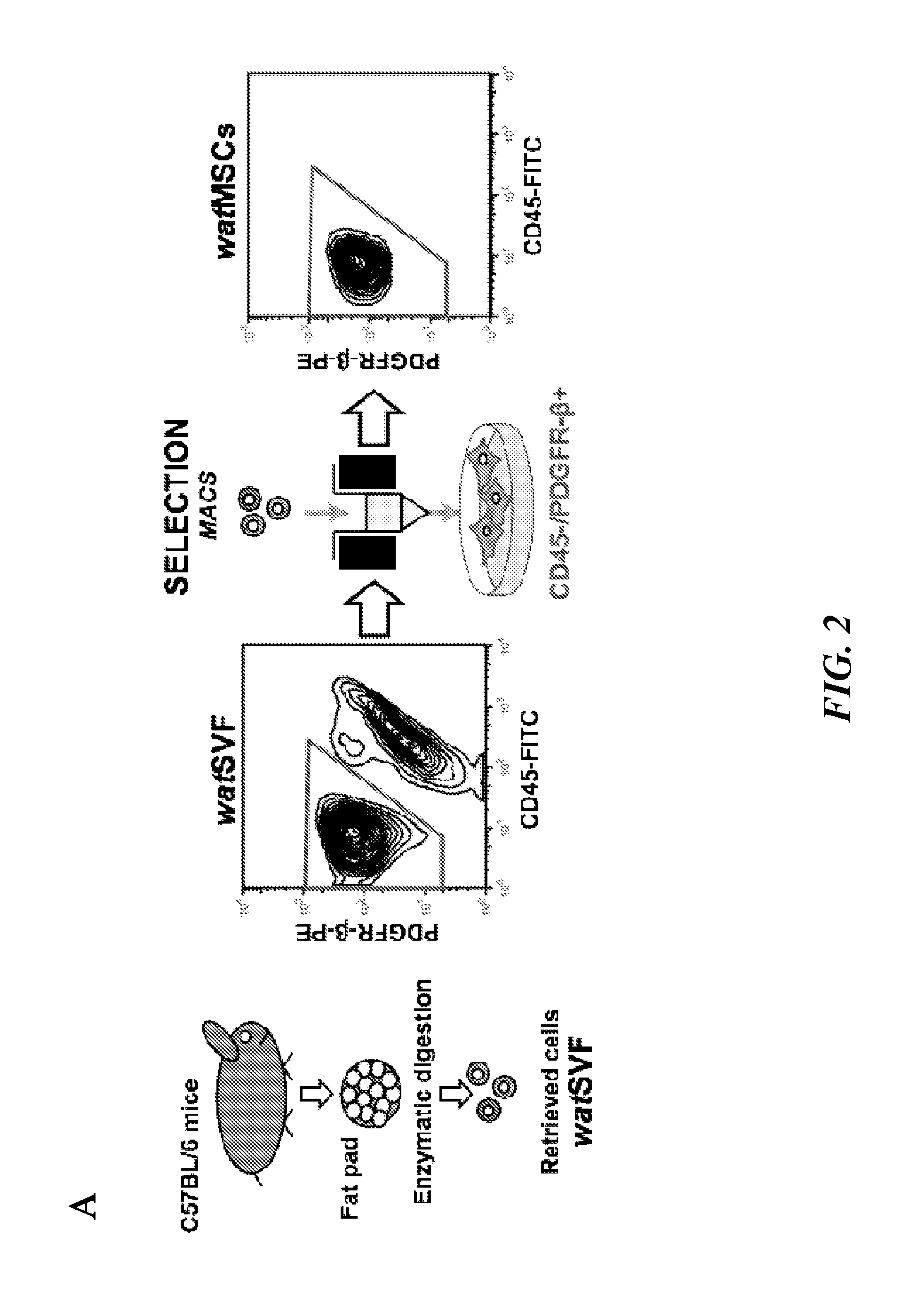Engineered vascular adipose tissue
a technology of vascular adipose tissue and vascular adipose tissue, which is applied in the direction of skeletal/connective tissue cells, biocide, artificial cell constructs, etc., can solve the problems of well vascularized adipose tissue for plastic, cosmetic and reconstructive purposes
- Summary
- Abstract
- Description
- Claims
- Application Information
AI Technical Summary
Benefits of technology
Problems solved by technology
Method used
Image
Examples
example 1
Neovascularization Regulates De Novo Adipogenesis
[0350]Here, the inventors show a progenitor cell-based approach to sequentially promote vasculogenesis and adipogenesis in vivo.
[0351]Endothelial progenitor cells from human umbilical cord blood (cbEPCs) and white adipose tissue (wat)-derived mesenchymal stem cells from GFP-057BL / 6 mice (gfp−watMSCs) were isolated. The isolated cells were expanded in culture and characterized prior to their use. To test their differentiation ability in vivo, MATRIGEL™ implants (200 μL) containing cbEPCs and gfp−watMSCs (40:60) were injected subcutaneously into immunodeficient mice. MATRIGEL™ implants were harvested at different time points and the presence of both new blood vessels and adipocytes were evaluated. Control implants were generated using gfp−watMSCs alone.
[0352]FIG. 1 shows the general plan for vasculogenesis and adipogenesis. Purified and defined adipose tissue-derived watMSCs and cord blood-derived cbEPCs are used to drive adipose tissue...
example 2
In Vivo Co-Cultures of ECFCs and Human watMSCs in MATRIGEL™
[0359]Characterization of Human Mesenchymal Stem Cells (h-MSC)
[0360]The inventors successfully isolated human mesenchymal stem cells (hMSCs) and characterized them prior to use in the various vasculogenic and adipogenic experiments. The MSC from various sources: bone marrow (h-bmMSCs), white adipose tissue (h-watMSCs) and code blood (h-cbMSCs), and ECFC were characterized by their cell surface markers as well as the ability of these cells to differentiate into the cell types that are typical of the mesenchymal lineage, e.g., bone, cartilage and fat cells. Flow cytometry analysis of h-bmMSC, h-watMSC, and human cord-blood derived endothelial colony-forming cells (h-cbECFC) for the mesenchymal marker CD90, the endothelial marker CD31, and hematopoietic marker CD45 is shown in FIG. 6A. Dotted lines represent cells stained with fluorescent antibodies. Isotype-matched controls are overlaid in a solid line on each panel. As expect...
example 3
In Vivo Co-Cultures of ECFCs and Human watMSCs in Collagen / Fibrin-Based Hydrogels
[0369]This experiment was performed to show that the same dense microvessel formation and adipogenesis take place in a collagen / fibrin-based gel instead of MATRIGEL™ as shown in Examples 1 and 2 (FIGS. 5 and 9).
[0370]A total of 1.2×106 h-watMSCs were resuspended in 200 μL of a collagen / fibrin-based gel in the presence or absence of 0.8×106 h-ECFC. The mixture was implanted on the back of 6-week-old GFP-expressing SCID mouse by subcutaneous injection. Implants were harvested after 4 weeks and compared to native murine adipose tissue. Macroscopic views of explant at 4 weeks are depicted in insets (FIG. 10A). H&E staining of sections taken from the explants at 4 weeks revealed the presence of adipose tissue (adipocytes). Representative H&E pictures are depicted at 10× and 40×. Adipocyte area fraction (%), adipocyte density (adipocyte / mm2), and average adipocyte size (μm2) were quantified in all groups and ...
PUM
 Login to View More
Login to View More Abstract
Description
Claims
Application Information
 Login to View More
Login to View More - R&D
- Intellectual Property
- Life Sciences
- Materials
- Tech Scout
- Unparalleled Data Quality
- Higher Quality Content
- 60% Fewer Hallucinations
Browse by: Latest US Patents, China's latest patents, Technical Efficacy Thesaurus, Application Domain, Technology Topic, Popular Technical Reports.
© 2025 PatSnap. All rights reserved.Legal|Privacy policy|Modern Slavery Act Transparency Statement|Sitemap|About US| Contact US: help@patsnap.com



